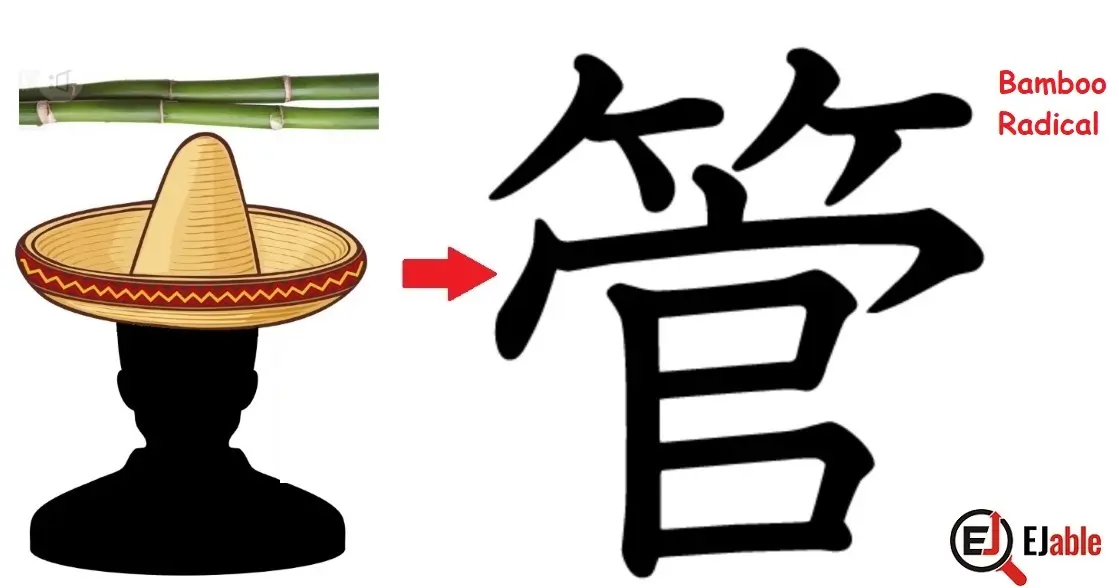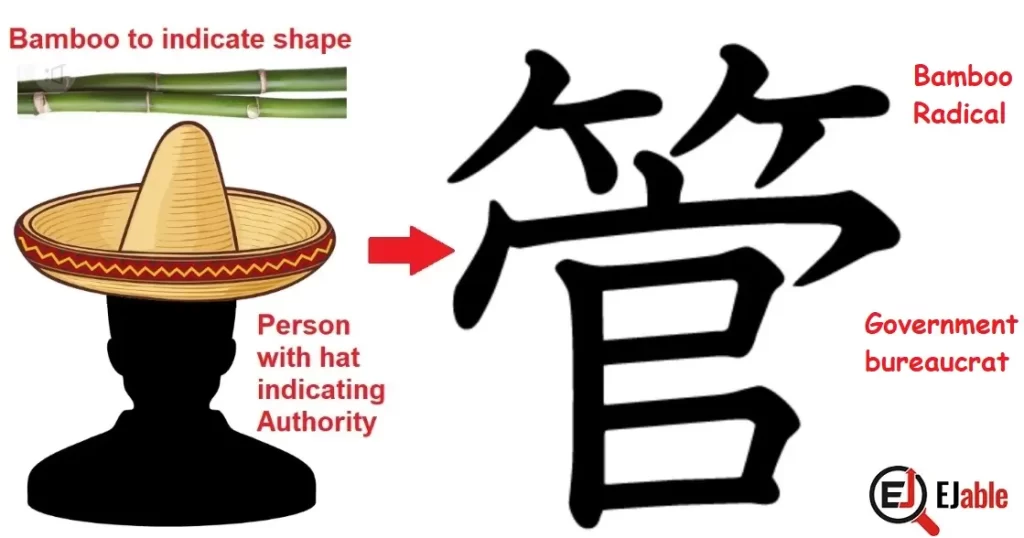Kanji for Pipe or Tube as a Conduit: 管 (kuda, くだ)

The Japanese Kanji for a pipe or tube is 管. The Kunyomi, or the Japanese, pronunciation of the Kanji 管 is (kuda,くだ), and the Onyomi (Chinese) pronunciation is kan (カン).
The Kanji represents long tubular objects used as a conduit for materials like fluid or gas, but not for other tubular objects, which the Kanji 筒 represents for tube or cylinder.
Pipe’s Kanji 管 is part of JLPT N2 and is taught in grade 4 in Japanese schools.
Construction of the Kanji 管
The Kanji 管 representing pipes or tubes has 14 strokes and has the following components:
- Kanji radical for Bamboo (⺮)
- Sub-component Kanji 官 (Kan)
(Note: You can read about the difference between Kanji radicals and sub-components in our guide to common Kanji radicals.)
Please also note that the sub-component 官 has the Kanji radical for the roof or crown at the top.
We are familiar with the Kanji, and it’s radical of Bamboo. However, interestingly, the sub-component 官 of Pipe’s Kanji 管 denotes the meaning related to government, bureaucrat, official, or control.
In the context of 管, it contributes to the abstract meanings related to management, control, or an administrative role.
Origin of Pipe’s Kanji 管
The Kanji for pipe 管 has an interesting origin as follows:
- The kanji 管 is believed to have originated from a pictograph of a bamboo flute.
- Historically, it depicted a bamboo section split open with dots representing the nodes of the bamboo, symbolizing the hollow interior of a pipe or flute.
- The lower part 官 denotes control or management.
- Over time, the character evolved into its current form, which retains the idea of a hollow tube but has become more abstract.
Mnemonic: How to Remember the Kanji 管 for Pipe or Tube
Though a pipe or tube facilitates transporting material from one place to another, this transportation is managed or controlled.
This simple logic is good enough to remember the Kanji 管 to represent a pipe with a cylindrical shape like bamboo (bamboo radical at the top), and the flow of material inside is controlled, represented by the Kanji-component 官 for control. This is unlike cylindrical objects like a tube or cylinders that contain material or a gun barrel.
However, the following picture will serve as a mnemonic to remember the kanji for pipe easily:


Explanation
- Consider the Kanji radical of bamboo at the top, indicating the cylindrical shape of the object, i.e., the pipe or tube.
- Consider the lower part 官 as an officer with a hat to control the flow.
Philosophical and Linguistic Context of the Kanji 管
Linguistically, the evolution of 管 from a bamboo flute to a broader representation of tubes, conduits, or channels also symbolizes the flow of influence or guidance, whether in music, administration, or communication. This transition from a specific, physical object to an abstract management or control concept reflects the Japanese language’s dynamic nature and cultural values.
In modern Japanese and Chinese contexts, 管 continues to symbolize administration and governance. Its use in compound words, such as 管理 (kanri, meaning “management”) in Japanese or 管辖 (guǎnxiá, meaning “jurisdiction”) in Chinese, underscores this fact.
These compound words reflect the cultural and philosophical values of East Asian societies, where governance and management are viewed as vital components of the structure and function of the society.
Pipe (Kan) Kanji in Compounded Words
There are 94 Japanese words that begin with the Kanji 管, and it appears in 534 words. Interestingly, these words range from physical objects to abstract ideas. Let’s have a look at the use of the pipe’s kanji in the Japanese language.
Please note that in the compounded words, mainly the Onyomi, or Chinese pronunciation kan (カン) for pipe’s kanji 管 is used.
Compounded Words with 管 for Physical Objects
The following are some examples of compound words in Japanese where the Kanji 管 is used in reference to physical objects:
- 水管 (すいかん / suikan): Water pipe (Japanese)
- ガス管 (がすかん / gasukan): Gas pipe (Japanese)
- 排水管 (はいすいかん / haisuikan): Drain pipe (Japanese)
- 風管 (ふうかん / fuukan): Windpipe, as in a musical instrument (Japanese)
- 煙管 (えんかん / enkan): Smoking pipe (Japanese)
- 気管 (きかん / kikan): Trachea or windpipe (Japanese)
- 鉄管 (てっかん / tekkan): Iron pipe (Japanese)
- 血管 (けっかん / kekkan): Blood vessel (Japanese)
- 導管 (どうかん / doukan): Conduit or duct (Japanese)
- 油管 (ゆかん / yukan): Oil pipe (Japanese)
- 管楽器 (かんがっき / kangakki): Wind instrument (Japanese)
These compound words illustrate the versatile use of 管 in both Japanese and Chinese, particularly in reference to various types of pipes, tubes, and conduits, as well as certain types of musical instruments and bodily organs.
Compounded Words with 管 for Abstract Ideas
Following are the examples of Japanese compound words where the Kanji for pipe 管 is used in the context of abstract ideas rather than physical objects:
- 管理 (かんり / kanri): Management or administration
- 管轄 (かんかつ / kankatsu): Jurisdiction or control
- 管制 (かんせい / kansei): Control, regulation, or command
- 責任管理 (せきにんかんり / sekininkanri): Responsibility management
- 管区 (かんく / kanku): District or sector (in administrative contexts)
- 資料管理 (しりょうかんり / shiryoukanri): Data or document management
- 情報管理 (じょうほうかんり / jouhoukanri): Information management
- 人事管理 (じんじかんり / jinjikanri): Personnel management or human resources
- 総務管理 (そうむかんり / soumukanri): General affairs management
- 財務管理 (ざいむかんり / zaimukanri): Financial management
- 教育管理 (きょういくかんり / kyouikukanri): Educational administration or management
- プロジェクト管理 (ぷろじぇくとかんり / purojekutokanri): Project management
- 設備管理 (せつびかんり / setsubikanri): Facility management
- システム管理 (しすてむかんり / shisutemukanri): System management or administration
- 保健管理 (ほけんかんり / hokenkanri): Health management
These compound words demonstrate the pipe’s Kanji 管 conceptual applications in Japanese. The interesting point is how the Japanese language connects the role of pipe or conduit with various forms of management, administration, and control in different contexts. These usages highlight this Kanji’s importance in conveying governance, organization, and oversight ideas.
These usages of the kanji of pipe for management and control are quite philosophical, considering that the role of the pipe is maintaining a continuous, disciplined, and controlled flow in the desired direction. And this is the foundational role of the management.
Check other Kanji characters on the page “How to Remember Kanji“. You may also like to read about the common Kanji radicals.


A long-term ex-pat in Japan, Himanshu comes with an IT background in SAP consulting, IT Business Development, and then running the country operations of an IT consulting multinational. Himanshu is the co-founder and Managing Director of ReachExt K.K. and EJable.com. He is also an Advisory Board Member of a Silicon Valley AI/IoT startup.

